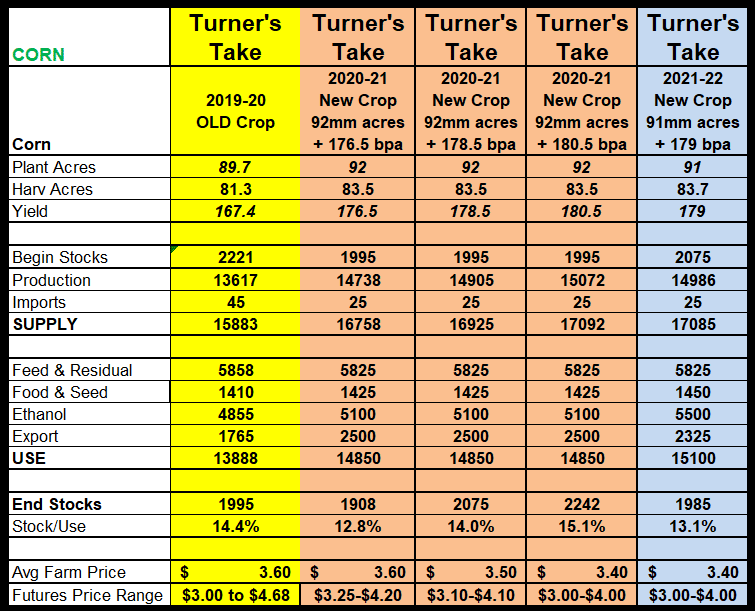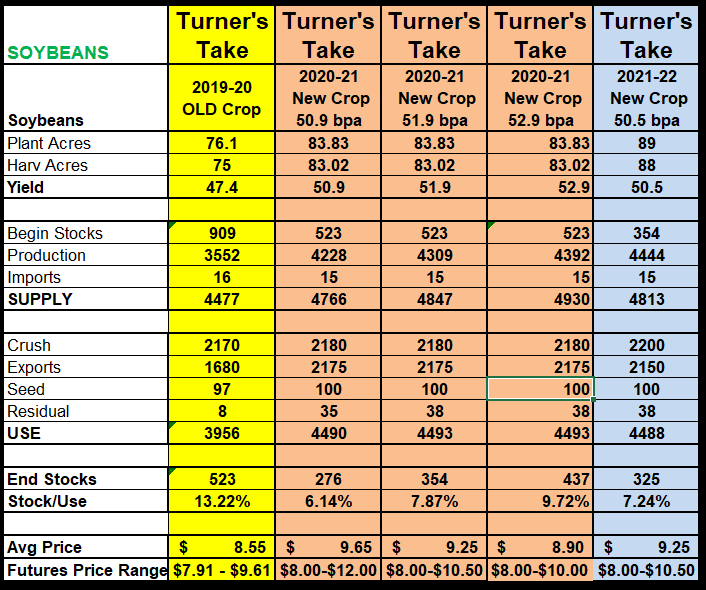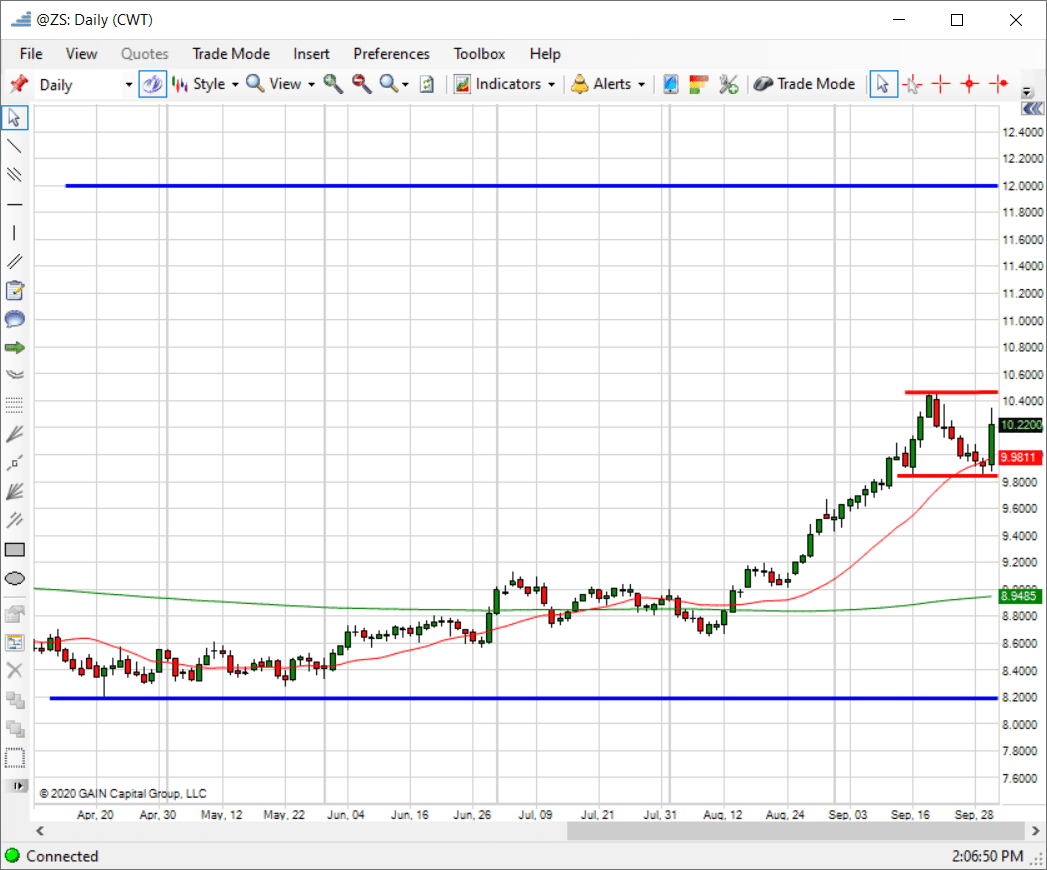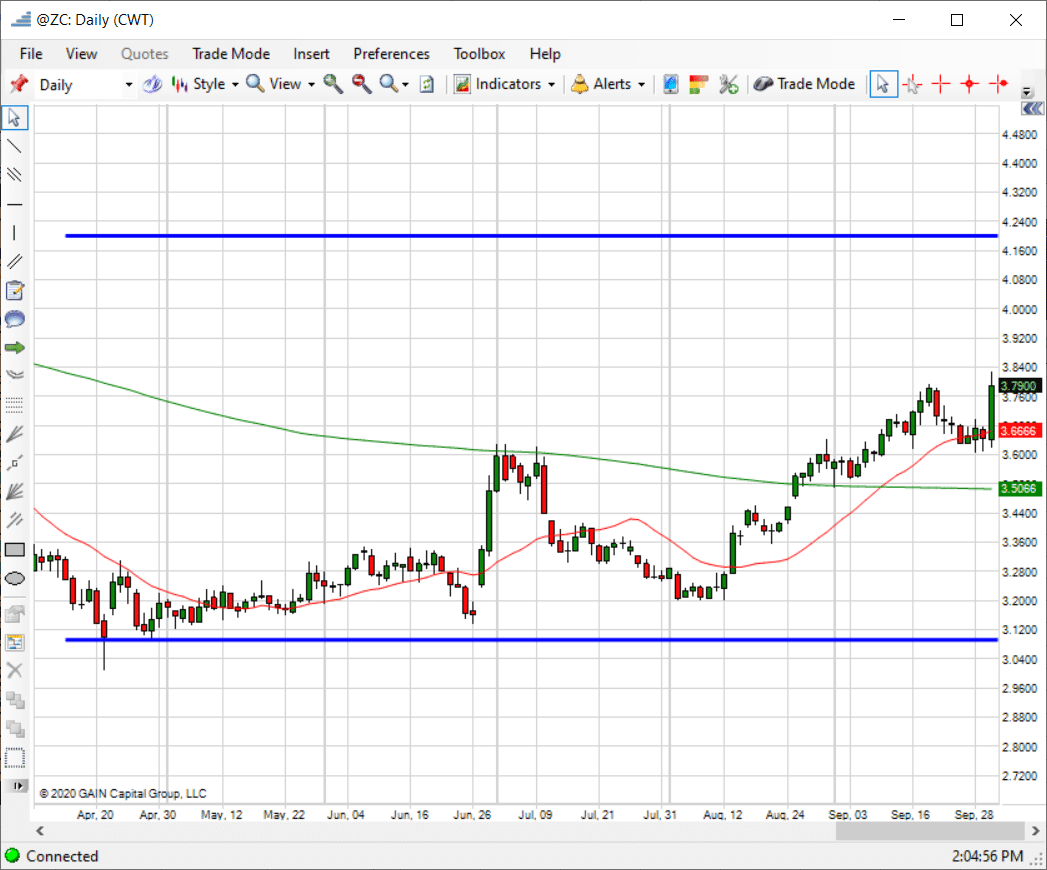
Play Turner’s Take Ag Marketing Podcast Episode 248
Podcast: Play in new window | Download
Subscribe: RSS | Subscribe to Turner's Take Podcast
If you are having trouble listening to the podcast, please click here for Turner’s Take Podcast episodes!
New Podcast
The quarterly stocks report was bullish across the board for corn, wheat, and soybeans. Grain stocks are getting tighter and it will make South American production even more important this fall and winter. Chinese demand will also be closely monitored. We expect large trading ranges for the grain markets and our bias is to the upside. Take a listen to Turner’s Take Podcast for details.
If you are not a subscriber to Turner’s Take Newsletter then text the message TURNER to number 33-777 to try it out for free! You may also click here to register for Turner’s Take.
Quarterly Stocks Bullish
Corn stocks were reduced to 1.995 billion, which is 223 million bushels lower than the Sept WASDE. Soybean stocks came down to 523 million and 52 million bushels lower than the last WASDE. While both are bullish in the old crop tables, the big reason for the rally today is what it means for new crop carryout and potentially the 2021-2022 crop year. Wheat was lowered 13mm bushels but that was expected. The reductions for corn and soybeans were bullish surprises.
If you are interested in working with Craig Turner for hedging and marketing, then click here to open an account. If you are a speculative or online trader then please click here.
Corn Supply & Demand
Below are my tables for old crop, new crop, and the 2021-2022 crop year that will not be planted until the spring of next year. Old crop is in the yellow column and we are under 2 billion. New crop is likely under 2.0 billion if yields continue to be reduced and we thing 176.5 is a reasonable assumption going into the next WASDE report. The last column in blue on the right assumes next year we have 91mm acres and a 179 bpa yield. That level of production means we grow as much as we use and carryout stays around 1.9 billion. That means we need a good South American crop during a La Nina year and at least 91mm acres next year with at least a trend line yield to stay around 1.9 billion.
Moral of the story is any weather issues in S America (La Nina) or the US in the spring could send corn into the $4s across the board. Add in more demand from China and corn is a very interesting markets. For now we think corn trades in a range of $3.50 to $4.20, which was the range it traded in after the drought years but before the Chinese tariffs.
For corn to trade in the mid $4s or higher, then the market has to think carryout is below 1.5 billion and stocks/usage is under 10%. South America and the Ukraine will not have as much corn this year to make up for losses in US production. There is a higher price potential for corn this year compared to last year IF (and it is a big IF) we have a major production issue South America and/or the United States.

Soybean Supply & Demand
Soybeans are starting to get tight and could be a real story over the next five to six months. Old crop came down to 523 million bushels and while that is not a big deal in a vacuum, it is a big deal when you take into account new crop and 2012-2022 soybeans.
The middle rows are different scenarios for new crop soybeans. Depending on the final yield ending stocks could range from 275 to 435mm bushels. 275 is tight while 435 is adequate. In that environment alone soybeans trades between $9 and $11. It also assumes a large South American crop. If La Nina hurts production this year we could see big rally in soybeans. A 5% loss of production in Argentina and/or Brazil could send “beans to the teens”.
Now take a look at the last column on the right in blue. To just keep 2021-2020 soybean stocks around 325mm, meaning we grow as much as we use year-over-year, the US needs to plant 89mm acres with a trend line 50.5 bpa yield. Soybeans needs to gains 5 to 6 million acres next year. Some acres that were unplanted this year will go to soybeans. Some acres might have to switch from corn to beans. Then consider 2021-2022 corn could be over $4 and then some based on what we wrote above. How much higher will soybean need to go in order to get those acres? I don’t know the exact number but it has to be supportive of soybeans.
If South America has record acres and a record crop, then corn stays around the mid to high $3s and soybeans are in the $9s and low $10s. Serious weather issues and strong Chinese demand could lead some big rallies later this fall/winter.


If you are interested in working with Craig Turner for hedging and marketing, then click here to open an account. If you are a speculative or online trader then please click here.
About Turner’s Take Podcast and Newsletter
If you are having trouble listening to the podcast, please click here for Turner’s Take Podcast episodes!
Craig Turner – Commodity Futures Broker
Turner’s Take Ag Marketing: https://www.turnerstakeag.com
Turner’s Take Spec: https://www.turnerstake.com
Twitter: @Turners_Take
Risk Disclosure
The StoneX Group Inc. group of companies provides financial services worldwide through its subsidiaries, including physical commodities, securities, exchange-traded and over-the-counter derivatives, risk management, global payments and foreign exchange products in accordance with applicable law in the jurisdictions where services are provided. References to over-the-counter (“OTC”) products or swaps are made on behalf of StoneX Markets LLC (“SXM”), a member of the National Futures Association (“NFA”) and provisionally registered with the U.S. Commodity Futures Trading Commission (“CFTC”) as a swap dealer. SXM’s products are designed only for individuals or firms who qualify under CFTC rules as an ‘Eligible Contract Participant’ (“ECP”) and who have been accepted as customers of SXM. StoneX Financial Inc. (“SFI”) is a member of FINRA/NFA/SIPC and registered with the MSRB. SFI does business as Daniels Trading/Top Third/Futures Online. SFI is registered with the U.S. Securities and Exchange Commission (“SEC”) as a Broker-Dealer and with the CFTC as a Futures Commission Merchant and Commodity Trading Adviser. References to securities trading are made on behalf of the BD Division of SFI and are intended only for an audience of institutional clients as defined by FINRA Rule 4512(c). References to exchange-traded futures and options are made on behalf of the FCM Division of SFI.
Trading swaps and over-the-counter derivatives, exchange-traded derivatives and options and securities involves substantial risk and is not suitable for all investors. The information herein is not a recommendation to trade nor investment research or an offer to buy or sell any derivative or security. It does not take into account your particular investment objectives, financial situation or needs and does not create a binding obligation on any of the StoneX group of companies to enter into any transaction with you. You are advised to perform an independent investigation of any transaction to determine whether any transaction is suitable for you. No part of this material may be copied, photocopied or duplicated in any form by any means or redistributed without the prior written consent of StoneX Group Inc.
© 2023 StoneX Group Inc. All Rights Reserved


You must be logged in to post a comment.